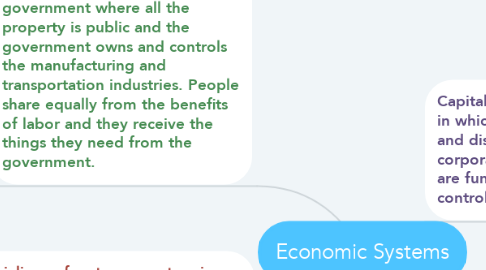Economic Systems
by Candance Gant

1. Socialism refers to any system in which the production and distribution of goods and services is a shared responsibility of a group of people. Socialism is based upon economic and political theories that advocate for collectivism. In a state of socialism, there is no privately owned properties.
1.1. Pros: Can create a system without classes. Can eliminates the socioeconomic gap. Can improve the standard of living for those who are struggling. Encourage people to work and produce; skill enhancement.
1.2. Cons: It can easily be manipulated by those in charge. Creates a race to the bottom so things might get bad enough for it to be made better. Limits innovation. Can reduce the workforce by enhancing and encouraging laziness.
2. Communism is system of government where all the property is public and the government owns and controls the manufacturing and transportation industries. People share equally from the benefits of labor and they receive the things they need from the government.
2.1. Pros: Capitalism encourage innovation. It is a society that is based on the service of others. Provides freedoms to its citizens. It promotes equality, it offers the opportunity at some level. Capitalism can provide a wider range of products and services than those that operate with government interference. You have opportunities to be involved in aspects of society to create the best possible outcome.
2.2. Cons: It can create an economy based on consumption. It can place the needs of companies and businesses above the needs of people. Equal opportunities can be brief and people can have limited access to resources. Can focused on those who can do and succeed compared to those who can't. Can lead to consolidation. Can force out competition from the market.
3. The United States has a mixed economy. I believe it is important to have an economic system because people can make decisions in the face of scarcity. Having a system puts a plan in place for those to make decisions on budget, trade, living standards, and etc. The purpose is to improve life and make their society a better place.
4. Capitalism is an economic system in which the means of production and distribution are privately or corporately owned. Operations are funded by profits, and not controlled by a state government.
4.1. Pros: Everyone gets the same chance. Almost everyone is employed. Almost everyone is educated. Agriculture and manufacturing are emphasized.
4.2. Cons: Individual rights are restricted. There is no unauthorized opposition. People are kept in ignorance. Violence tends to be the only option for dissent. Earning is limited. No savings are allowed. Employment may go up and down, but meaningful employment goes down.
5. Mixed Economy consists of both companies and government/state owned entities. Both have control of owning, making, selling, and exchanging goods in the country. It can contain features of both planned and market economies.
5.1. Pros: Equal Distribution of control. More efficiency for private firms. Freedom for private enterprise to thrive on their own. A defined role for the government as referee. Safe haven from poverty. Greater chance for the government to implement good policies. More job investments coming in.
5.2. Cons: Challenge of finding a balance. Government going to far. Excessive intervention by the government. Limited corporate size. Higher taxes.


